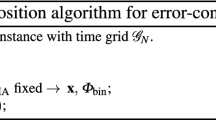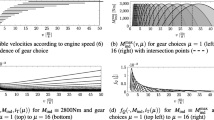Abstract
We present a control problem for an electrical vehicle. Its motor can be operated in two discrete modes, leading either to acceleration and energy consumption, or to a recharging of the battery. Mathematically, this leads to a mixed-integer optimal control problem (MIOCP) with a discrete feasible set for the controls taking into account the electrical and mechanical dynamic equations. The combination of nonlinear dynamics and discrete decisions poses a challenge to established optimization and control methods, especially if global optimality is an issue. Probably for the first time, we present a complete analysis of the optimal solution of such a MIOCP: solution of the integer-relaxed problem both with a direct and an indirect approach, determination of integer controls by means of the sum up rounding strategy, and calculation of global lower bounds by means of the method of moments. As we decrease the control discretization grid and increase the relaxation order, the obtained series of upper and lower bounds converge for the electrical car problem, proving the asymptotic global optimality of the calculated chattering behavior. We stress that these bounds hold for the optimal control problem in function space, and not on an a priori given (typically coarse) control discretization grid, as in other approaches from the literature. This approach is generic and is an alternative to global optimal control based on probabilistic or branch-and-bound based techniques. The main advantage is a drastic reduction of computational time. The disadvantage is that only local solutions and certified lower bounds are provided with no possibility to reduce these gaps. For the instances of the electrical car problem, though, these gaps are very small. The main contribution of the paper is a survey and new combination of state-of-the-art methods for global mixed-integer optimal control and the in-depth analysis of an important, prototypical control problem. Despite the comparatively low dimension of the problem, the optimal solution structure of the relaxed problem exhibits a series of bang-bang, path-constrained, and sensitivity-seeking arcs.



Similar content being viewed by others
References
Ascher, U., Mattheij, R., Russell, R.: Numerical Solution of Boundary Value Problems for Ordinary Differential Equations. SIAM, Philadelphia (1995)
Bemporad, A., Borodani, P., Mannelli, M.: Hybrid control of an automotive robotized gearbox for reduction of consumptions and emissions. In: Hybrid Systems: Computation and Control, Springer Lecture Notes in Computer Science, vol. 2623/2003, pp. 81–96. Springer, Heidelberg (2003). doi:10.1007/3-540-36580-X_9
Betts, J.: Practical Methods for Optimal Control Using Nonlinear Programming. SIAM, Philadelphia (2001)
Biegler, L.: Solution of dynamic optimization problems by successive quadratic programming and orthogonal collocation. Comput. Chem. Eng. 8, 243–248 (1984)
Biegler, L.: Nonlinear Programming: Concepts, Algorithms, and Applications to Chemical Processes. Series on Optimization. SIAM, Philadelphia (2010)
Bock, H., Longman, R.: Optimal control of velocity profiles for minimization of energy consumption in the New York subway system. In: Proceedings of the Second IFAC Workshop on Control Applications of Nonlinear Programming and Optimization, pp. 34–43. International Federation of Automatic, Control (1980)
Bock, H., Longman, R.: Computation of optimal controls on disjoint control sets for minimum energy subway operation. In: Proceedings of the American Astronomical Society. Symposium on Engineering Science and Mechanics. Taiwan (1982)
Bock, H., Plitt, K.: A multiple shooting algorithm for direct solution of optimal control problems. In: Proceedings of the 9th IFAC World Congress, pp. 242–247. Pergamon Press, Budapest (1984)
Borrelli, F., Bemporad, A., Fodor, M., Hrovat, D.: An MPC/hybrid system approach to traction control. IEEE Trans. Control Syst. Technol. 14(3), 541–552 (2006). doi:10.1109/TCST.2005.860527
Borrelli, F., Falcone, P., Keviczky, T., Asgari, J., Hrovat, D.: MPC-based approach to active steering for autonomous vehicle systems. Int. J. Veh. Auton. Syst. 3(2–4), 265–291 (2005)
Bulirsch, R.: Die Mehrzielmethode zur numerischen Lösung von nichtlinearen Randwertproblemen und Aufgaben der optimalen Steuerung. Tech. rep, Carl-Cranz-Gesellschaft, Oberpfaffenhofen (1971)
Chachuat, B., Singer, A., Barton, P.: Global methods for dynamic optimization and mixed-integer dynamic optimization. Ind. Eng. Chem. Res. 45(25), 8373–8392 (2006)
De Jager, B., Van Keulen, T., Kessels, J.: Optimal Control of Hybrid Vehicles. Advances in Industrial Control. Springer, London (2013)
Gamkrelidze, R.: Principles of Optimal Control Theory. Plenum Press, Berlin (1978)
Gerdts, M.: Solving mixed-integer optimal control problems by branch&bound: a case study from automobile test-driving with gear shift. Optim. Control Appl. Methods 26, 1–18 (2005)
Gerdts, M.: A variable time transformation method for mixed-integer optimal control problems. Optim. Control Appl. Methods 27(3), 169–182 (2006)
Gerdts, M., Sager, S.: Mixed-integer DAE Optimal control problems: necessary conditions and bounds. In: Biegler, L., Campbell, S., Mehrmann, V. (eds.) Control and Optimization with Differential-Algebraic Constraints, pp. 189–212. SIAM, Philadelphia (2012)
Hellström, E., Ivarsson, M., Aslund, J., Nielsen, L.: Look-ahead control for heavy trucks to minimize trip time and fuel consumption. Control Eng. Pract. 17, 245–254 (2009)
Henrion, D., Daafouz, J., Claeys, M.: Optimal switching control design for polynomial systems: an LMI approach. In: 2013 Conference on Decision and Control. Florence, Italy (2013). Accepted for publication
Henrion, D., Lasserre, J.B., Löfberg, J.: Gloptipoly 3: moments, optimization and semidefinite programming. Optim. Methods Softw. 24(4–5), 761–779 (2009)
Jansson, C.: VSDP: a Matlab software package for verified semidefinite programming. Nonlinear Theory and its Applications pp. 327–330 (2006)
Jung, M., Reinelt, G., Sager, S.: The Lagrangian Relaxation for the Combinatorial Integral Approximation Problem. Optimization Methods and Software (2014). (Accepted)
Kim, T.S., Manzie, C., Sharma, R.: Model predictive control of velocity and torque split in a parallel hybrid vehicle. In: Proceedings of the 2009 IEEE International Conference on Systems. Man and Cybernetics, SMC’09, pp. 2014–2019. IEEE Press, Piscataway, NJ (2009)
Kirches, C., Bock, H., Schlöder, J., Sager, S.: Mixed-integer NMPC for predictive cruise control of heavy-duty trucks. In: European Control Conference, pp. 4118–4123. Zurich, Switzerland (2013)
Kirches, C., Sager, S., Bock, H., Schlöder, J.: Time-optimal control of automobile test drives with gear shifts. Optim. Control Appl. Methods 31(2), 137–153 (2010)
Lasserre, J.B.: Positive Polynomials and Their Applications. Imperial College Press, London (2009)
Lasserre, J.B., Henrion, D., Prieur, C., Trélat, E.: Nonlinear optimal control via occupation measures and LMI-relaxations. SIAM J. Control Optim. 47(4), 1643–1666 (2008)
Lee, H., Teo, K., Jennings, L., Rehbock, V.: Control parametrization enhancing technique for optimal discrete-valued control problems. Automatica 35(8), 1401–1407 (1999)
Leineweber, D.: Efficient reduced SQP methods for the optimization of chemical processes described by large sparse DAE models, Fortschritt-Berichte VDI Reihe 3, Verfahrenstechnik, vol. 613. VDI Verlag, Düsseldorf (1999)
Leineweber, D., Bauer, I., Bock, H., Schlöder, J.: An efficient multiple shooting based reduced SQP strategy for large-scale dynamic process optimization. Part I: theoretical aspects. Comput. Chem. Eng. 27, 157–166 (2003)
McShane, E.: The calculus of variations from the beginning to optimal control theory. SIAM J. Control Optim. 27(5), 916–939 (1989)
Merakeb, K., Messine, F., Aïdène, M.: A branch and bound algorithm for minimizing the energy consumption of an electrical vehicle. 4OR (2013, available online)
Osborne, M.: On shooting methods for boundary value problems. J. Math. Anal. Appl. 27, 417–433 (1969)
Royden, H., Fitzpatrick, P.: Real Analysis. Prentice Hall, Upper Saddle River (2010)
Sager, S.: Numerical methods for mixed-integer optimal control problems. Der andere Verlag, Tönning, Lübeck, Marburg (2005). ISBN 3-89959-416-9
Sager, S.: Reformulations and algorithms for the optimization of switching decisions in nonlinear optimal control. J. Process Control 19(8), 1238–1247 (2009)
Sager, S., Bock, H., Diehl, M.: The integer approximation error in mixed-integer optimal control. Math. Program. A 133(1–2), 1–23 (2012)
Sager, S., Jung, M., Kirches, C.: Combinatorial integral approximation. Math. Methods Oper. Res. 73(3), 363–380 (2011). doi:10.1007/s00186-011-0355-4
Sager, S., Reinelt, G., Bock, H.: Direct methods with maximal lower bound for mixed-integer optimal control problems. Math. Program. 118(1), 109–149 (2009)
Sargent, R., Sullivan, G.: The development of an efficient optimal control package. In: Stoer, J. (ed.) Proceedings of the 8th IFIP Conference on Optimization Techniques (1977), Part 2. Springer, Heidelberg (1978)
Sciarretta, A., Guzzella, L.: Control of hybrid electric vehicles. IEEE Control Syst. 27(2), 60–70 (2007)
Scott, J.K., Chachuat, B., Barton, P.I.: Nonlinear convex and concave relaxations for the solutions of parametric ODEs. Optim. Control Appl. Methods 34, 145–163 (2013). doi:10.1002/oca.2014
Sturm, J.F.: Using SeDuMi 1.02, a Matlab toolbox for optimization over symmetric cones. Optim. Methods Softw. 11–12, 625–653 (1999)
Tauchnitz, N.: Das Pontrjaginsche Maximumprinzip für eine Klasse hybrider Steuerungsprobleme mit Zustandsbeschränkungen und seine Anwendung. Ph.D. thesis, BTU Cottbus (2010)
Terwen, S., Back, M., Krebs, V.: Predictive powertrain control for heavy duty trucks. In: Proceedings of IFAC Symposium in Advances in Automotive Control, pp. 451–457. Salerno, Italy (2004)
van Keulen, T., van Mullem, D., de Jager, B., Kessels, J.T.B.A., Steinbuch, M.: Design, implementation, and experimental validation of optimal power split control for hybrid electric trucks. Control Eng. Pract. 20(5), 547–558 (2012)
Acknowledgments
The authors gratefully acknowledge financial support by the BMBF Grant “GOSSIP” (S. Sager), by the Engineering and Physical Sciences Research Council under Grant EP/G066477/1 (M. Claeys), and by the Grant ANR 12-JS02-009-01 “ATOMIC” (F. Messine).
Author information
Authors and Affiliations
Corresponding author
Rights and permissions
About this article
Cite this article
Sager, S., Claeys, M. & Messine, F. Efficient upper and lower bounds for global mixed-integer optimal control. J Glob Optim 61, 721–743 (2015). https://doi.org/10.1007/s10898-014-0156-4
Received:
Accepted:
Published:
Issue Date:
DOI: https://doi.org/10.1007/s10898-014-0156-4




